ETFs are major components of the stock market today. But what is an ETF investment, which is the best ETF to invest in, and how can you evaluate each ETF investment? Read on to learn more about how ETFs work, how to evaluate ETF performance and a few ideas to start your investigation into this diverse asset type.
What is an Exchange-Traded Fund (ETF)?
What is an ETF, exactly? "ETF" stands for "exchange-traded fund." The "exchange" in the ETF meaning refers to the major stock exchanges these funds trade on.
ETFs are collections of stocks that trade together the same way as a typical share of stock. Most ETFs center around a particular theme that connects the assets. For example, an ETF might include some of the largest producers in one specific industry, smaller companies with the potential for growth or stocks with high dividend yield rates. In addition to stocks, ETFs may invest in assets like bonds, currencies and other debt instruments.
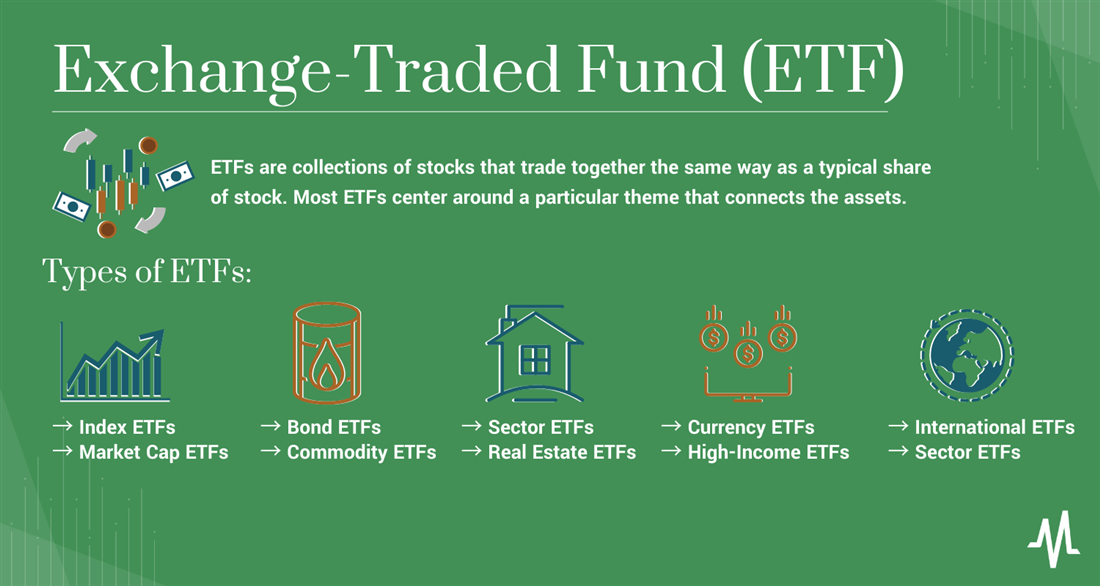
How Do ETFs Work?
What is an ETF in investing, and how are they created? ETFs work by pooling investors' money to create a diversified portfolio of underlying securities, which usually follow some theme. The ETF might track a particular stock market index, or it might be hand-selected by a group of fund managers.
ETFs are structured to match the performance of their underlying index or asset class. The fund managers aim to maintain a portfolio that mirrors the composition of the benchmark they are tracking. An ETF might be passively managed by tracking a benchmark and maintaining a specific portfolio allotment or actively managed over time by fund managers in an attempt to outperform the market.
Types of ETFs
There are multiple types of ETFs, and the best ETF investment for your portfolio might vary depending on your investing needs and goals. The following are some of the most popular types of ETFs you'll see on the market when you compare investment options.
Index ETFs
Index ETFs, sometimes referred to simply as "index funds," are exchange-traded funds that aim to replicate the performance of a major market index, such as the S&P 500. These ETFs are designed to passively track the index by holding a diversified portfolio of securities that closely mirrors the index's composition and weighting.
The goal of an index ETF is to replicate the performance of the index that it tracks. It accomplishes this by investing in the same underlying assets as the index itself. For example, an S&P 500 index ETF would hold stocks of the 500 companies included in the S&P 500 index. Index ETFs can be an ideal choice for a passive, long-term financial goal like saving for retirement because they are usually low-cost and designed to withstand market fluctuations.
Market Cap ETFs
Market cap ETFs focus on companies based on their market capitalization. You can calculate market capitalization by multiplying the price of an individual share of stock by the total outstanding number of shares. From small-cap companies that provide you with room for growth to large-cap companies that dominate their respective industries, market cap ETFs group investments by market prominence.
Bond ETFs
Bond ETFs are lower-risk securities that invest in fixed-income assets, including corporate and municipal bonds. Bonds are debt instruments issued by governments, corporations or other entities to raise capital and are lower-risk investments because they have insurance from the underlying body issuing the bond. Bond ETFs further diversify your investment by investing in themed bonds.
Commodity ETFs
Commodity ETFs provide exposure to commodities bought and sold throughout the day on international markets. Some examples of commodities that an ETF might invest in include precious metals, energy products and agricultural goods like sugar and wheat.
These ETFs typically use derivatives like futures contracts to gain exposure to the underlying commodities. By utilizing futures contracts, these ETFs can provide investors with indirect ownership of the physical commodities without requiring direct storage or delivery.
Sector ETFs
If you're interested in investing in a specific segment of the market but want to avoid individual stocks, a sector ETF could be the ideal option. Sector ETFs invest in a particular market segment, incorporating multiple companies from the sector into the ETF. For example, a consumer discretionary ETF might invest in stocks from companies like The Walt Disney Company NYSE: DIS, Starbucks Corporation NASDAQ: SBUX and Royal Caribbean Cruises Ltd. NYSE: RCL, all in the same fund.
Real Estate ETFs
Real estate ETFs provide investors with a more affordable and convenient way to invest in the real estate market when compared to owning physical property. Real estate ETFs invest in companies holding assets related to real estate, including real estate investment trusts (REITs) and mortgage holding companies. Many real estate ETFs also qualify as income ETFs thanks to the REIT requirement to pay at least 90% of profits in dividends.
Currency ETFs
Interested in the forex market but don't want to take the risk of active trading? A currency ETF allows investors to take advantage of fluctuations in currency values across countries. Currency ETFs track the performance of a specific currency's exchange rates relative to another currency, such as the U.S. dollar. Some ETFs invest in a basket of currencies in the same way that a sector ETF will invest in a series of companies. Investors can use currency ETFs to gain exposure to foreign currency movements, hedge against currency risk or speculate on currency exchange rate changes based on current events.
High-Income ETFs
High-income ETFs invest in securities that produce consistent and competitive dividends for investors. These ETFs invest in a diversified portfolio of income-generating assets, such as high-yield bonds, preferred stocks, dividend-paying stocks and REITs. High-income ETFs may have higher expense ratios, which you should note when considering which assets to invest in.
International ETFs
International ETFs invest in securities outside the United States, providing exposure to competing markets. International ETFs usually track specific international indexes like the MSCI EAFE Investable Market Index, making them similar to other index funds on this list. An international ETF might provide exposure to developing countries or established international competitors.
ETFs vs. Index Funds
The words "ETF" and "index fund" sometimes intersect. When an ETF tracks an index, some investors may refer to it as both an index fund and an ETF. However, in some cases, ETFs have a general edge over index funds, which are often structured as mutual funds. The offer:
- Intraday flexibility: ETFs provide investors with intraday trading flexibility, allowing them to take advantage of price movements and implement various trading strategies. Index funds that trade as mutual funds do not offer this level of intraday flexibility.
- Creation and redemption processes: ETFs have a unique creation and redemption process that involves authorized participants, allowing them to create or redeem shares in large blocks. This process helps to keep the ETF's share price closely aligned with the value of its underlying holdings. Index funds do not have this creation and redemption mechanism.
- Transparency concerns: ETFs must disclose their holdings daily, allowing investors to see the underlying securities and their allocations. Index funds may have more flexibility in terms of disclosure frequency and may not be required to reveal their complete holdings daily. It can make it more difficult for you to know exactly what you're buying into.
ETFs vs. Mutual Funds
While ETFs and mutual funds are baskets of assets that pool money together from investors, they differ in key trading and pricing aspects:
- Trading method: ETFs are traded on stock exchanges throughout the day, just like individual stocks. Mutual funds are bought and sold through the fund company at the net asset value (NAV) price at the end of the trading day.
- Price: ETFs generally have lower expense ratios than mutual funds, making them a more cost-effective investment option for many investors. Mutual funds tracking an index or otherwise passively managed have lower expense ratios than actively managed funds.
- Viable trading strategies: ETFs offer more flexibility in trading strategies, such as short selling, buying on margin or using limit orders, while mutual funds may have restrictions or additional fees associated with these trading activities. Mutual funds may also have large minimum initial investment amounts equal to thousands of dollars, while the minimum to invest in an ETF is always one share of the fund at market price.
| |
ETFs
|
Mutual funds
|
Index funds
|
|
Minimum investment requirements
|
Price of one share
|
Set by mutual company
|
Variable depending on structure
|
|
Structure
|
May be actively or passively managed depending on what the index tracks
|
May be actively managed by institutional managers
|
Tracks an underlying index; usually passively managed
|
|
Fees
|
Average expense ratio of 0.16%
|
Average expense ratio of 0.39%
|
Average expense ratio of 0.2% for passively managed funds
|
|
Accessibility
|
Traded during regular business hours like shares of stock
|
Purchased at the end of the trading day by the mutual fund company
|
Variable depending on structure
|
|
Transparency
|
Legally required to reveal holdings to potential investors on a daily basis
|
Not required to reveal holdings
|
Usually elect to reveal holdings when not required by law
|
Popular ETFs and Indexes
Ready to take a look at ETFs performances and their returns over time? The following are a few examples of the most popular ETFs and the indexes that they track.
Let’s take a closer look at the ETFs listed above and how they benefit investors.
SPDR S&P 500 ETF Trust
The SPDR S&P 500 ETF Trust NYSE: SPY is one of the world's largest and most popular ETFs. Its mission is to provide investors with exposure to the performance of the S&P 500 Index, a widely recognized benchmark of the U.S. stock market. SPY aims to replicate the index's performance by holding a diversified portfolio of stocks that closely mirrors the index composition.
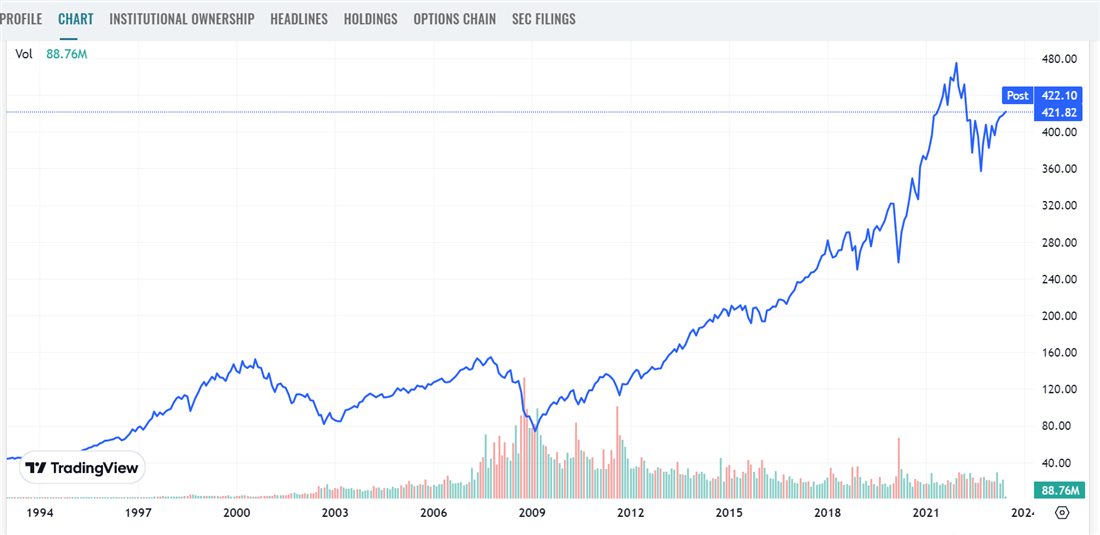
Image: SPY is one of the largest index funds in the world, with a total of $397 billion in assets under management.
Vanguard Mega Cap ETF
The Vanguard Mega Cap ETF NYSE: MGC invests in mega-cap, blue-chip stocks that dominate their industries. It tracks the CRSP U.S. Mega Cap Index, which represents the largest companies in the U.S. equity market when sorted by total market capitalization. Some of the fund's largest holdings include Apple Inc. NASDAQ: AAPL and Microsoft Corporation NASDAQ: MSFT.
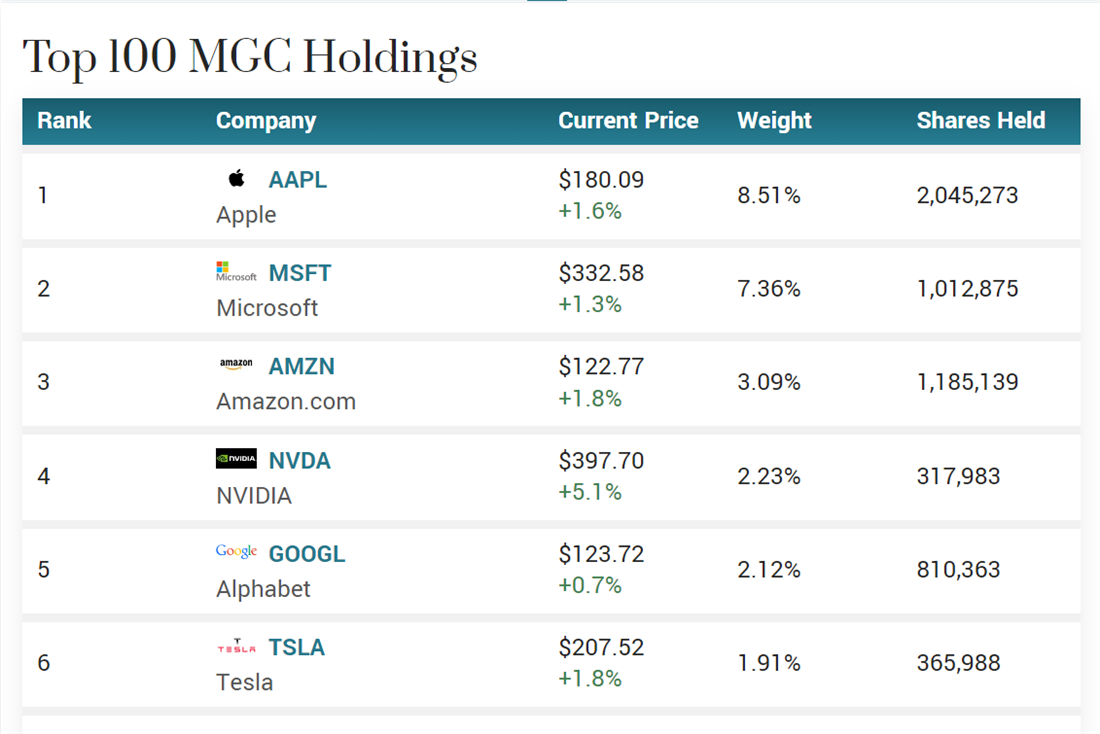
Image: Tech stocks dominate MGC’s holdings due to their high market caps.
Fidelity Total Bond ETF
The Fidelity Total Bond ETF NYSE: FBND can be a great option if you want exposure to the broad U.S. bond market. The FBND tracks the Bloomberg Barclays U.S. Universal Bond Index, which includes a diverse range of fixed-income securities such as government bonds, corporate bonds and mortgage-backed securities. It's an option if you're looking for the stability of bond protections.
SPDR Gold Shares
Gold investors frequently choose the SPDR Gold Shares ETF NYSE: GLD when they want to add exposure to the gold commodity market to their portfolios. Each share of the ETF represents a fractional ownership interest in the trust, which holds physical gold bars in secure vaults. Unlike most ETFs, GLD does not track a particular index and instead showcases value based on the changing value of gold bullion on the international market.

Image: An investment in GLD is an investment in one asset: gold.
Consumer Discretionary Select Sector SPDR Fund
The Consumer Discretionary Select Sector SPDR Fund NYSE: XLY is an ETF that provides investors with a convenient way to invest in a series of leisure and luxury companies. It tracks the Consumer Discretionary Select Sector Index, representing companies selling non-essential goods throughout the United States. Some of the fund's top holdings are in Amazon.com NASDAQ: AMZN, Tesla Inc. NASDAQ: TSLA and The Home Depot Inc. NYSE: H.D..
Vanguard Real Estate ETF
A real estate ETF may provide diversified access to a particular property market segment without the massive upfront investment required to own property directly. The Vanguard Real Estate ETF NYSE: VNQ invests in both Vanguard-owned and third-party real estate opportunities according to the MSCI US RIT Index.
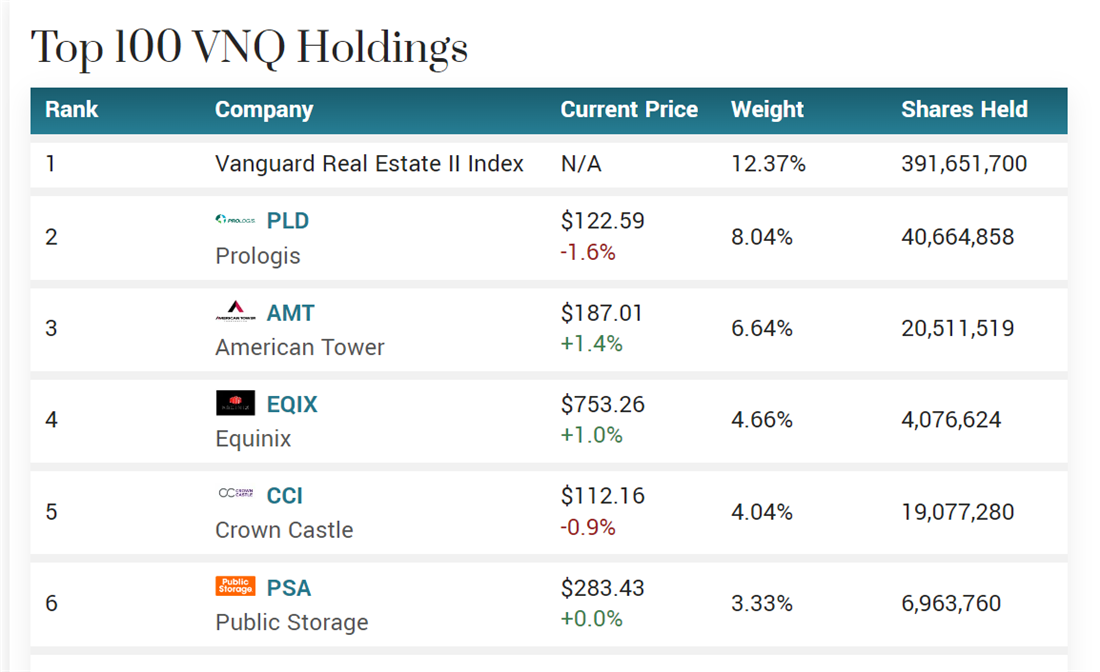 Image: VNQ’s largest holding is Vanguard’s own real estate index fund offering.
Image: VNQ’s largest holding is Vanguard’s own real estate index fund offering.
Invesco DB US Dollar Index Bullish Fund
The Invesco DB U.S. Dollar Index Bullish Fund NYSE: UUP is designed to track the performance of the U.S. dollar relative to a basket of major currencies. UUP seeks to replicate the price and yield performance of the Deutsche Bank Long USD Currency Portfolio Index, which consists of futures contracts on six currencies: the euro, Japanese yen, British pound, Canadian dollar, Swedish krona and Swiss franc. Investing in UUP can expose you to the U.S. dollar's movements against these currencies.
Amplify High Income ETF
If you're looking to invest in ETFs to create a consistent stream of dividend income, a high-income option like the Amplify High Income ETF NYSE: YYY might be an appealing choice. YYY utilizes a multi-asset income strategy, investing in a diversified portfolio of high-yield bonds, dividend stocks and covered call options. The fund seeks to generate attractive income for investors by targeting securities with high yields, combining fixed-income and equity investments to enhance income generation while managing risk.
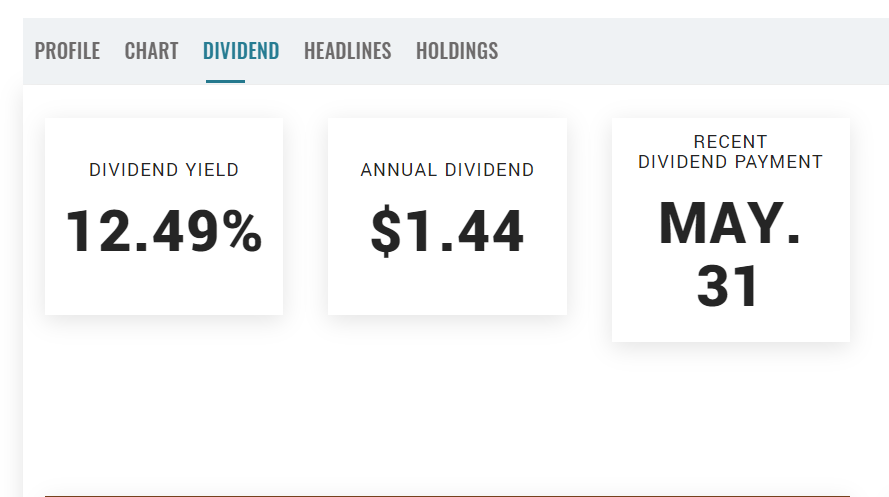 Image: YYY’s high dividend yield makes it a popular choice among investors looking for income generation.
Image: YYY’s high dividend yield makes it a popular choice among investors looking for income generation.
Vanguard Total International Stock ETF
The Vanguard Total International Stock ETF NASDAQ: VXUS provides investors with broad exposure to international equity markets. Its underlying stock index, the FTSE Global All Cap ex U.S. Index, is a market-cap-weighted index of global stocks, covering about 99% of the world's global market capitalization outside the United States. It includes assets from emerging and established international markets, providing wider exposure for investors.
How to Buy ETFs
Now that we've answered the question, "What are ETFs?" and defined a few popular market options, you might be excited to begin placing orders to invest. Go through the following basic steps to start investing in ETFs.
Step 1: Open a brokerage account.
A brokerage account is a crucial tool you'll use as a retail investor to buy and sell shares of stock and ETFs throughout the trading day. If you still need to get a brokerage account, explore the specific markets that each option provides access to, as well as trading fees, maintenance fees and commissions before opening an account.
Step 2: Review fund holdings.
Unlike mutual funds, ETFs are required by the SEC to reveal their entire list of holdings to potential investors each day. Before investing in an ETF, review its major holdings to ensure the fund's stated goals and assets are in sync. If you cannot view ETF holdings directly through your brokerage account, a resource like MarketBeat's stock and ETF database can be crucial in researching ETF options.
Step 3: Create a buy order.
After choosing an ETF, create a buy order through your brokerage account. Search for the stock's ticker to view current market pricing and decide how much you'll pay per share. If your broker can fill the order according to your specifications, you'll see the shares in your portfolio.
Step 4: Monitor your investment.
Like a share of stock, you'll notice your ETF shares change in price throughout the day. Monitor your shares and set a stop-loss order if you're using a short-term trading strategy.
How to Choose ETFs
Selecting ETFs as an investor involves managing your expectations and reducing overall portfolio risk. Here's a step-by-step guide to help with the selection process.
- Define your investment objectives. Clarify your investment goals, and define what you want from your investments. For example, you might want to create a stream of passive income now, or you might want to select assets that will increase in value over time. Understanding your objectives will guide you in selecting ETFs that align with your desired outcomes.
- Determine your risk tolerance: Assess your risk tolerance level, which refers to your comfort with potential market volatility. ETFs can vary in risk exposure depending on the underlying assets that make up the fund. Choose ETFs that match your risk tolerance and suit your investment time horizon.
- Conduct research: Examine the fund's investment strategy, holdings, historical performance, expense ratio and the index or benchmark it tracks if it operates as an index fund. Review the fund's prospectus and other available materials to gain insights into its objectives and risks to ensure they align with your goals before investing.
- Diversify your holdings: As the old saying goes, you should never put your eggs into one basket. This is especially true when investing in ETFs, which may show similar volatility to stocks depending on their underlying assets. Consider continuing your education and spreading your capital between multiple funds to diversify your portfolio further.
Remaining proactive and current with market trends and consumer preferences can help enhance your returns as an ETF investor.
Pros and Cons of ETFs
Be sure to consider both the benefits and potential drawbacks of investing in ETFs before risking your investment funds.
Pros
ETFs provide an enhanced level of safety for your portfolio and some potential tax advantages.
- Instant diversification: ETFs include a basket of assets, which you become a partial owner of when you invest in the ETF. ETFs provide an instant way to diversify your portfolio and is easier than choosing individual stocks.
- Lower expenses: ETFs have lower expense ratios compared to mutual funds. Since ETFs are passively managed and usually aim to track an index, they have lower operating costs, resulting in potentially higher net returns for investors.
- Potential tax advantages: Some ETF dividends are qualified, meaning you'll pay the capital gains tax rate rather than the standard income tax rate typically applied to non-qualified dividends. This usually means tax savings for investors.
Cons
While ETFs are diverse assets, there are better options for investors who want complete control over their capital funds.
- No control over holdings: ETF investors have limited control over the specific securities held within the fund. Suppose you have specific preferences or want to avoid certain companies or industries. In that case, you don't have direct control over the fund's holdings like you could simply avoid buying a particular company's stock.
- Expense ratios: Unlike holding individual stocks, you must pay expense ratios when holding ETFs. Over time, expense ratios that are too high can significantly cut into investor returns.
Becoming an ETF Investor
While ETFs provide a more stable option when compared to investing in individual shares of stock, it's important to remember that the same market factors influence these assets. However, unlike stocks, investors must also be wary of the expense ratios of holding ETFs, which are payments made to the company that manages the fund. If you're looking for affordable ETFs to hold in the long term, look for those that track a major index, which are more likely to have low expense ratios due to higher market competition.
FAQs
Interested in learning more about the most active ETFs today? The following are some of the most common last-minute questions about ETFs.
Are ETFs good investments?
ETFs can be great investment choices for investors looking for diversification, liquidity and more affordable fund holdings. There may be better choices for investors looking for direct control over all holdings in their portfolio or who want to actively manage their own portfolios to avoid fees.
What is an ETF and how does it work?
An ETF is an investment vehicle that pools money from multiple investors to buy a diversified portfolio of stocks, bonds and other assets. ETFs offer investors an easy way to gain exposure to a specific market or asset class without buying individual stocks. Their value fluctuates throughout the trading day based on their underlying assets, like stocks.
How do ETFs make you money?
ETFs earn money by dividing investor funds between multiple stocks, bonds and other assets likely to increase in value over time. Investors see their shares of the fund increase after investing in ETFs, returning value to their portfolios. Many ETFs also return value by offering dividend payments.